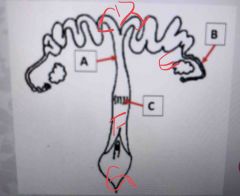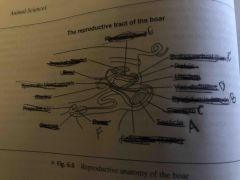![]()
![]()
![]()
Use LEFT and RIGHT arrow keys to navigate between flashcards;
Use UP and DOWN arrow keys to flip the card;
H to show hint;
A reads text to speech;
45 Cards in this Set
- Front
- Back
- 3rd side (hint)
|
Hormones of Male Reproduction Where are they being made? What’s their target cell? What is the end result? |

Embryo is performed and grows/enlarges during development
Theory accepted until 19th century |
|
|
|
What is epigenesis? |
-man arises from The successor of differentiation of a formless and being -embryo is organized from the mother’s menstrual blood after being acted on by semen |
|
|
|
What do the Wolffian (mesonephric) ducts develop into? |
Epididymis, ductus deferens, seminal vesicle, urethra |
E, DD, SV, U |
|
|
What do Müllerian ducts develop into? |
Oviduct, uterus, cranial (upper) vagina |
O, U, CV |
|
|
What gene drives the gonads to become testes? What chromosome is it located on? |
The Sex-determining Region of the Y chromosome |
SRY |
|
|
Does a female have the SRY gene? |
No |
|
|
|
If there is Sertoli cells or MIS? |
Müllerian ducts develop |
|
|
|
If there is no Leydig cells or testosterone? |
Wolffian ducts regress |
|
|
|
What is freemartin? |
Abnormal embryogenesis of the female reproductive tract |
|
|
|
How does freemartin happen? |
Heifer born twin to bull -> share a common blood supply from the placenta in utero -> exposed to same hormones -> inhibited growth of Müllerian ducts -> ovaries fail to grow and produce estrogen -> genetic female behaves as bull |
|
|
|
What are the major functions of the ovaries? |
Oogenesis, folliculogenesis, estrogen and progesterone production |
|
|
|
What are the major functions of the oviduct? |
Site of fertilization Transport of oocyte and sperm |
|
|
|
What are the major functions of the uterus? |
Fetal development, control of cyclicity and luteolysis, sperm transport |
|
|
|
Why are the major functions of the cervix? |
Protects sterile uterine environment, passageway for sperm and fetus |
|
|
|
What are the major functions of the vagina? |
Female organ of copulation |
|
|
|
What are the major functions of the vulva? |
External genitalia Protection for vagina from outside environment |
|
|
|
Hormones of Female Reproduction
where are they being produced? what are their target cells? what is the elicited response? |
ovaries; granulosa cells; induces growth of follicles in ovary by binding FSH-receptors on granulosa cells |
|
|
|
oogenesis when is meiosis arrested? when does it resume? are females born with all potential gametes? |
stops at prophase I; puberty; yes |
|
|
|
Granulosa cells |
line the antrum of pre-ovulatory follicle, have FSH receptors with primary action of follicular development and estrogen synthesis |
|
|
|
theca cells |
have LH receptors -> stimulation of ovulation, formation of CL, progesterone secretion (CL) |
|
|
|
corpus luteum |
large “yellow bodies” that produce progesterone, formed from granulosa and thecal cells after ovulation |
|
|
|
corpus albicans |
white, scar-like structure that represents degenerating CL, increasing connective tissue, decreasing secretory tissue |
|
|
|
What follicle is ovulated? |
Pre-ovulatory/dominant follicle |
|
|
|
Key differences between female avian reproductive tract and mammals tract |
Offspring development doesn’t occur in the body; only left ovary is functional; don’t form CL; have infundibulum, stigma, magnum, and isthmus, uterus also known as shell gland; no cervix; has cloaca |
|
|
|
Avian ovary |
Contains yolk, has stigma (where ovulation occurs) |
|
|
|
Avian infundibulum |
Fertilization of ovum, fertilized or not process of egg formation continues |
|
|
|
Avian magnum |
Ovum moves here after fertilization, spends 2-3 hours in magnum, thick albumen (egg white) deposited around yolk |
|
|
|
Avian isthmus |
Two thin shell membranes deposited around albumen (after magnum), spends 1.5 hours here, ovum takes up water and mineral salts |
|
|
|
Avian shell gland/uterus |
Spends 18-20 hours here, more albumen added, plumping (water and minerals diffuse in), calcification of shell, pigment added |
|
|
|
Avian vagina |
Cuticle added, seals pores present in shell |
|
|
|
Avian vent/cloaca |
Common orifice for copulation, defecation, and egg expulsion |
|
|

Front (Term) |
A: uterine body B: oviduct C: cervix D: uterine horns E: ovary F: vagina G: vulva |
|
|

Front (Term) |
A: testes B: epididymis C: scrotum D: ductus deferens E: accessory sex glands F: penis |
|
|
|
Testes |
Testosterone production (leydig cells), spermatogenesis |
|
|
|
Epididymis |
Concentration, storage, maturation, and transport of sperm |
|
|
|
Scrotum |
Support of testes and temperature regulation |
|
|
|
Ductus deferens |
Sperm transport |
|
|
|
Accessory sex glands |
Addition of fluid, nutrients, buffers to semen |
|
|
|
Penis |
Male copulatory organ |
|
|
|
What is the passageway of sperm from seminiferous tubules to the epididymis |
Ductus deferens |
|
|
|
The where, what, when, why, and how of spermatogenesis |
Where: seminiferous tubules What: mitosis and meiosis of male gametes When: during the breeding season or constitutively Why: to produce continuous supply of mature male gametes How: Sertoli cells, leydig cells, blood-testis barrier |
|
|
|
hormones of male reproduction: where are they being produced? what are their target cells? what is the elicited response? |
testes; leydig cells; make testosterone in response to LH secretion which causes spermatogenesis |
|
|
|
what is the general structure of the spermatozoon? |
head (nucleus), midpiece (mitochondria), tail (flagellum) |
|
|
|
tissues of the penis: vascular vs. fibroelastic |
vascular: enlarges by retaining blood in the erectile tissue (stallions, humans, dogs) fibroelastic: increases in length but not diameter, very small amount of blood for erection, straightening of sigmoid flexure by relaxation of retractor penis muscle (bull, ram, boar) |
|
|
|
cryptorchidism |
when the testes fail to descend unilateral: one fails |
|

